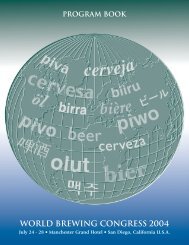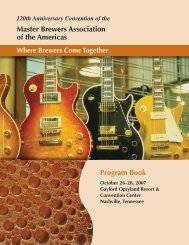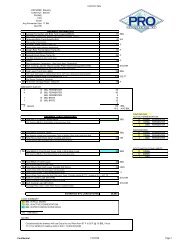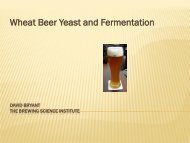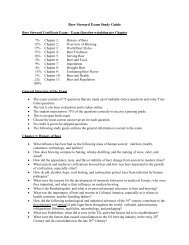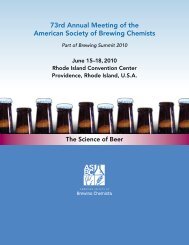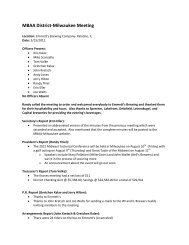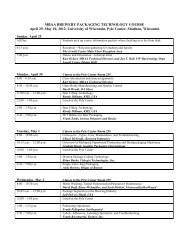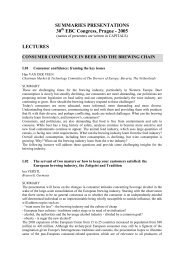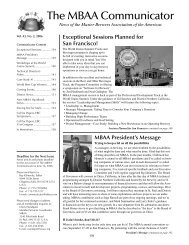Program Book - The Master Brewers Association of the Americas
Program Book - The Master Brewers Association of the Americas
Program Book - The Master Brewers Association of the Americas
You also want an ePaper? Increase the reach of your titles
YUMPU automatically turns print PDFs into web optimized ePapers that Google loves.
O-38<br />
Applications for yeast as an inert carrier<br />
Presenter: Craig Duckham, Cara Technology Limited,<br />
Lea<strong>the</strong>rhead, UK<br />
Coauthor(s): Bill Simpson, Cara Technology Limited,<br />
Lea<strong>the</strong>rhead, UK<br />
As <strong>the</strong> agent <strong>of</strong> fermentation, yeast and yeast technology are areas<br />
with which brewers are well acquainted. But, <strong>the</strong>re is more to<br />
yeast. In <strong>the</strong> last decade considerable progress has been made in<br />
<strong>the</strong> exploitation <strong>of</strong> yeast as an inert carrier <strong>of</strong> small molecules.<br />
While commercial products consisting <strong>of</strong> mineral-enriched (particularly<br />
zinc-enriched) yeast cells have been used by brewers<br />
for some time, <strong>the</strong> potential for encapsulating o<strong>the</strong>r chemicals in<br />
yeast is less widely known. Materials that can be encapsulated<br />
within dead yeast include flavors, antioxidants, and vitamins. <strong>The</strong><br />
benefits <strong>of</strong> encapsulation can include dramatic improvements in<br />
<strong>the</strong> stability <strong>of</strong> encapsulated molecules against heat, light, and<br />
moisture. <strong>The</strong> products formed as a result <strong>of</strong> encapsulation can be<br />
stored dry. Volatile and <strong>of</strong>ten flammable flavors can be handled<br />
more easily and shipped and stored with few restrictions. Yeast is<br />
a natural alternative to o<strong>the</strong>r encapsulation materials and <strong>of</strong>fers<br />
unique performance benefits. A number <strong>of</strong> encapsulation technologies<br />
using yeast have been developed and refined, many <strong>of</strong> which<br />
are protected by patents. In some cases, materials can be stabilized<br />
in yeast at levels as high as 45% by weight <strong>of</strong> <strong>the</strong> powdered or<br />
granulated end product. In this paper, <strong>the</strong> potential for application<br />
<strong>of</strong> <strong>the</strong>se yeast encapsulation technologies is critically evaluated<br />
with respect to <strong>the</strong>ir manufacture and use in beverage systems to<br />
improve flavor, flavor stability, appearance, and nutritional value.<br />
Potential opportunities are explored, and aspects related to legal<br />
issues and labeling are discussed. <strong>The</strong> potential use <strong>of</strong> waste brewery<br />
yeast for encapsulation <strong>of</strong> materials for non-food applications<br />
(such as pesticides, herbicides, antibacterials, antifungals, essential<br />
oils, etc.) is also discussed.<br />
Craig Duckham is a specialist in <strong>the</strong> industrial application <strong>of</strong><br />
yeasts. He joined Cara Technology Limited as director <strong>of</strong> operations<br />
and development in 2009. In this role he has responsibility<br />
for <strong>the</strong> company’s pure yeast culture development and manufacturing<br />
operations in <strong>the</strong> United Kingdom and Denmark. He is responsible<br />
for Cara’s collection <strong>of</strong> more than 700 industrial brewing<br />
yeast strains. From 2002 to 2008 Craig worked for Micap plc,<br />
in <strong>the</strong> end as technical director. <strong>The</strong> Micap business was focused<br />
on nano-encapsulation <strong>of</strong> chemicals, including flavors, within<br />
yeast. Prior to Micap he spent four years as principal development<br />
scientist with Thames Water plc. Following completion <strong>of</strong><br />
his Ph.D. degree at Nottingham University, he carried out postdoctoral<br />
work at <strong>the</strong> Universities <strong>of</strong> Lancaster and Reading in <strong>the</strong><br />
United Kingdom. Craig has published more than 30 peer-reviewed<br />
papers, patents, and book chapters.<br />
O-39<br />
A rational approach to yeast strain selection in product<br />
development<br />
Presenter: Bill Simpson, Cara Technology Limited, Lea<strong>the</strong>rhead,<br />
UK<br />
Coauthor(s): Chris Giles, Hilary Flockhart, and Craig Duckham,<br />
Cara Technology Limited, Lea<strong>the</strong>rhead, UK<br />
Up until <strong>the</strong> first commercial application <strong>of</strong> yeast “clones” to<br />
make beer in 1883, yeasts were recycled from one fermentation<br />
to ano<strong>the</strong>r, <strong>of</strong>ten over centuries. For example, if a yeast culture<br />
failed due to microbiological contamination, a replacement culture<br />
was obtained from ano<strong>the</strong>r, usually local, brewery. Thus, in many<br />
ways, <strong>the</strong> year 1883 represents a significant landmark for brewing:<br />
<strong>the</strong> year in which <strong>the</strong> biodiversity <strong>of</strong> <strong>the</strong> yeasts used to make<br />
beer first came under threat. Since that time, hand in hand with <strong>the</strong><br />
rise <strong>of</strong> multi-national brewery groups, national brewers, and independent<br />
breweries, which all rely on centralized supplies <strong>of</strong> yeast<br />
cultures, <strong>the</strong> number <strong>of</strong> yeast strains used to make <strong>the</strong> world’s beer<br />
supply has declined. It is estimated that more than 40% <strong>of</strong> <strong>the</strong><br />
world’s beer (including lagers, ales, stouts, and even wheat beers)<br />
is fermented and/or re-fermented with one single strain <strong>of</strong> lager<br />
yeast. This change has simplified things for <strong>the</strong> brewer. Handling<br />
multiple yeast strains in a single brewery can be demanding, and<br />
cross-contamination <strong>of</strong> one culture with ano<strong>the</strong>r is an ever-present<br />
risk. But, such simplicity has a cost. Beers that have been made<br />
with <strong>the</strong> same yeast have to rely on differences in malt, adjuncts,<br />
hops, water, and process parameters (such as <strong>the</strong> amount <strong>of</strong> each<br />
material and <strong>the</strong> temperature and time <strong>of</strong> each process step) for<br />
<strong>the</strong>ir distinctiveness. By homogenizing <strong>the</strong> yeast supply, it could<br />
be argued that brewers are missing an important color from <strong>the</strong>ir<br />
brewing palate. In this paper we will discuss how <strong>the</strong> current<br />
situation can be resolved. Considering <strong>the</strong> processes involved in<br />
developing a new product, we will look at <strong>the</strong> choices to be made<br />
in terms <strong>of</strong> raw materials, yeast strain, production processes, and<br />
product positioning. We will explore how genetic, microbiological,<br />
and biochemical information on individual yeast strains can be<br />
married to multi-variate statistical sensory analysis tools, including<br />
principal component analysis and internal preference mapping.<br />
Our aim is to show how rational selection <strong>of</strong> yeast strains can be<br />
aligned to systematic product and process design to create highly<br />
targeted products that carry a greater chance <strong>of</strong> commercial success<br />
in <strong>the</strong> marketplace.<br />
Bill Simpson joined Scottish brewer Tennent Caledonian Breweries<br />
in 1977 as a trainee microbiologist. Studying part-time he gained<br />
a first-class honors degree in microbiology and a lot <strong>of</strong> brewery<br />
experience before embarking on a nine-year program <strong>of</strong> research<br />
with <strong>the</strong> Brewing Research Foundation (BRF) in England. During<br />
that time he published extensively in areas such as flavor chemistry,<br />
brewery microbiology, and yeast. He rose to <strong>the</strong> position <strong>of</strong><br />
principal scientist and head <strong>of</strong> fermentation before leaving BRF in<br />
1995 to start two companies—Cara Technology and FlavorActiV.<br />
In addition to his ongoing research in <strong>the</strong> areas <strong>of</strong> beer flavor<br />
chemistry, sensory science, and yeast, Bill consults for a number<br />
<strong>of</strong> international brewery groups, with particular emphasis<br />
on process problem solving. He won <strong>the</strong> Institute <strong>of</strong> Brewing &<br />
Distilling’s (IBD’s) Cambridge Prize for Brewing Research for his<br />
work on hop bitter acids and beer spoilage bacteria in 1991 and<br />
has published more than 100 scientific papers, books, and patents<br />
on brewing technology. Bill is a Fellow <strong>of</strong> <strong>the</strong> IBD and a member<br />
<strong>of</strong> <strong>the</strong> editorial board <strong>of</strong> <strong>the</strong> Journal <strong>of</strong> <strong>the</strong> American Society <strong>of</strong><br />
Brewing Chemists.<br />
35



